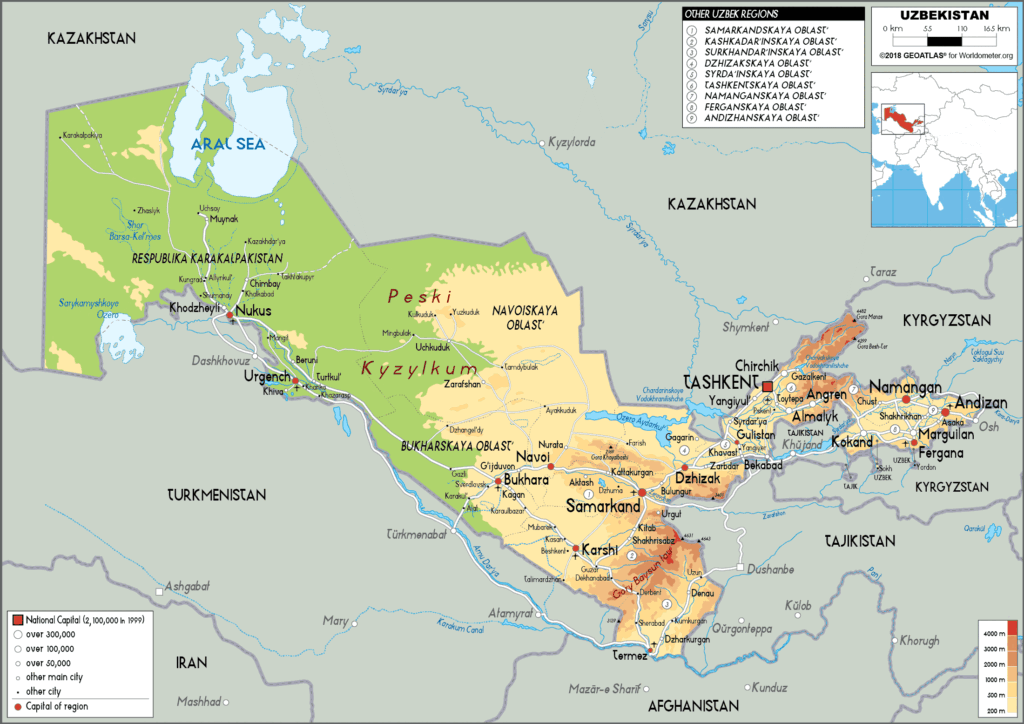

MBA ’24 in Supply Chain Management & Supply Chain Professional/Enthusiast
Introduction
As a passionate MBA student and advocate for supply chain management, I am eager to shed light on the distinctive supply chain landscape of my home country, Uzbekistan. Positioned in the heart of Asian continent, Uzbekistan shares its borders with Kazakhstan to the west and north, Afghanistan and Turkmenistan to the south, and Kyrgyzstan and Tajikistan to the east (see Figure 1).

Decoding Uzbekistan’s Supply Chain: A Comprehensive Look at SCM Challenges
Uzbekistan is a unique case in the realm of supply chain dynamics due to its double landlocked status, making it devoid of any access to the sea (Luxembourg is the only other country in this category globally). This geographical feature significantly shapes the intricacies of Uzbekistan’s supply chain.
Traditionally, key trading partners include Russia, China, and Kazakhstan (ITA, 2022). Exports focus on commodities like gold, precious metals, cotton, and agricultural products (Worldstopexports, 2022). Uzbekistan’s unique geological landscape and product characteristics have led to the dominance of multimodal containerized cargo movement in trade. This mode not only shapes market prices, but also significantly influences the country’s pricing structure. Container pricing volatility, heightened during the pandemic, is further impacted by heavy reliance on truck driver availability and railway load capacity. This dependence becomes more pronounced due to the seasonality of key products like cotton and agricultural goods, affecting transport rates.
Uzbekistan’s economic progress depends extensively on efficiently managing supply chain costs to alleviate inflationary pressures. Furthermore, the challenges arising from the Russia-Ukraine war have notably affected the region’s oil and diesel sectors. Uzbekistan faces hurdles such as negative net trade in global oil exchanges and complications arising from post-Soviet geopolitical fragility.
For instance in 2021, Uzbekistan reported a negative net trade of (-) $234 million in imported crude oil from Turkmenistan, Kazakhstan, and Russia (OEC.World, 2021), impacting diesel prices crucial for land containerized transport. By January 2024, Uzbekistan’s diesel price was around $3.48 per US gallon, compared to neighboring Turkmenistan at $1.4 per US gallon and Kazakhstan at $2.42 per US gallon, both of whom benefit from direct sea access (GlobalPetrolPrices.com, 2024). These dynamics underscore the challenges faced by landlocked Uzbekistan in managing price fluctuations that are further exacerbated by geopolitical factors.
Recommendations for Enhancing Uzbekistan’s Supply Chain
It is evident that Uzbekistan stands to benefit significantly from prioritizing supply chain optimization across various business scales. As a supply chain expert deeply connected to the country, my recommendation underscores the critical importance of enhancing transparency and efficiency in the transportation tendering process. It is crucial to avoid prolonged reliance on a single service provider and foster a more flexible and competitive landscape to achieve this goal. Additionally, internal route optimization and planning tools within organizations can offer valuable insights. Relying solely on external vendors and third-party logistics providers may not suffice. Alternatively, in-house capabilities will ensure a better understanding of transportation minimization strategies.
Technological integration is at the core of supply chain transformation in Uzbekistan. While some large firms such as Korzinka and IMZO Group have successfully integrated ERP systems like SAP, there’s still a substantial number relying on basic tools or Excel sheets for inventory management. Despite the considerable investment involved in SAP integration, the potential cost of losing customers and facing business closure outweighs this financial commitment.
At the government level, integrating Procure-to-Pay systems (such as SAP Ariba) is imperative. This integration minimizes the inefficient use of financial resources and fosters greater transparency among various stakeholders, ultimately promoting fair transactions.
In essence, a harmonious blend of technology, well-grounded supply chain concepts, and individuals with a profound understanding of these elements is crucial for navigating the complexities of Uzbekistan’s current business landscape.
Lessons Learned from Personal Experience
I experienced these challenges firsthand during the COVID-19 pandemic while leading the establishment of an automotive Greenfield project in Uzbekistan collaborating with brands like Volkswagen and Skoda. The global automotive sector was encountering unexpected vulnerabilities, notably the microchip shortage, which impacted our project directly.
Individuals with my expertise played a vital role in saving the company. Faced with unpredictable local customer demands, our team experienced a sudden shortage of cars, emphasizing the need for proactive contingency planning, thorough supply chain mapping, and a deep understanding of suppliers and risks.
Drawing from these experiences, my current professional recommendation for businesses is to involve specialized supply chain professionals in all expansion and cost minimization projects. Their expertise in planning, sourcing, and risk management can adeptly navigate uncertainties, optimize operations, and fortify overall business resilience.
Is the Study of Supply Chain Management Crucial in Developing Nations?
I strongly believe in the importance of fostering a robust cadre of supply chain specialists, both by nurturing talent internally and by providing opportunities for exposure and learning in industry-leading foreign countries. This approach not only contributes to the growth of the supply chain field domestically, but also allows for the infusion of global best practices and expertise, further enhancing the overall development trajectory.
The increasing recognition of Supply Chain Management in developing nations, particularly in Uzbekistan, is a positive trend. Observing the rise of talented professionals with such backgrounds is encouraging as supply chain management holds vital importance for any developing country. This is exemplified by historical development patterns in nations like the USA, where the efficient construction of transnational railways played a pivotal role in significant developmental leaps. The establishment of roles in this field and the ascent of industry leaders are noteworthy characteristics.
Grainger Center and SCM Program Highlights
The Supply Chain Program at Wisconsin School of Business boasts a commendable 6th position among USA public schools and 17th globally. This provides an outstanding opportunity for individuals in search of valuable insights. The program’s combination of business acumen and a focus on Supply Chain specialization adds significant value to the industry. The program’s network of industry professionals and lecturers with hands-on experience nurtures a dynamic learning environment, consistently presenting opportunities to gain fresh perspectives and knowledge.
The University of Wisconsin Madison’s supply chain management studies include a thorough exploration of incorporating technology into various processes. This includes digital platforms, data analytics, automation, inventory visibility, logistical coordination, channel strategy, and sourcing. The program delves deep into strategies designed to strengthen supply chain resilience, especially in the current global landscape influenced by trends like friendshoring and reshoring. Most notably this involves the development of localized strategies, particularly within key industries such as microchips, which adds a compelling dimension and provides insights applicable to various supply chain scenarios.
Moreover, collaborative initiatives with distinguished companies such as Meta and Deloitte create opportunities for active participation in case competitions, thereby enriching the overall learning experience. For instance, I had the privilege of engaging with my team and securing the second-place position in a case competition hosted by the FAANG company Meta and gained valuable insights into their sourcing strategies. Taking on the role of a graduate assistant is another advantage of the program. For instance, my position as a Teaching Assistant for International Business department involved conducting a comprehensive examination of regulatory frameworks governing trade and commerce in the USA. This scrutiny, coupled with a background in supply chain management studies, facilitated an understanding of how to streamline international business practices for more efficient trade processes—crucial concepts for developing nations.
In essence, program at the Grainger Centers places substantial emphasis on sustainability and resilience in modern supply chain studies by assessing factors such as environmental impact, ethical considerations, and the capability of supply chains to endure disruption.